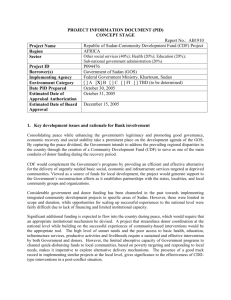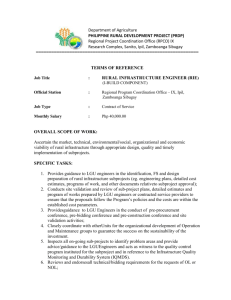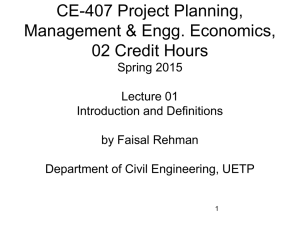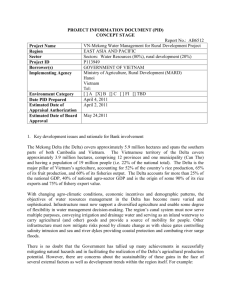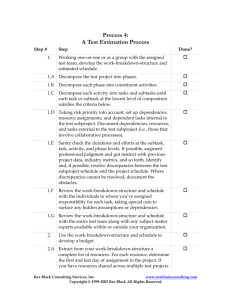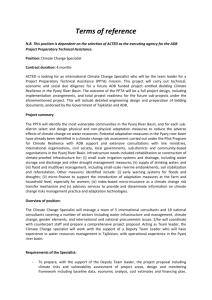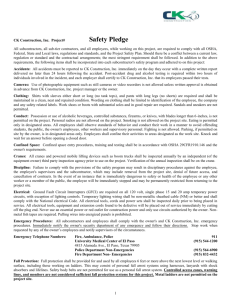Using Genetic Algorithms for Investigating Specific Regions of
advertisement
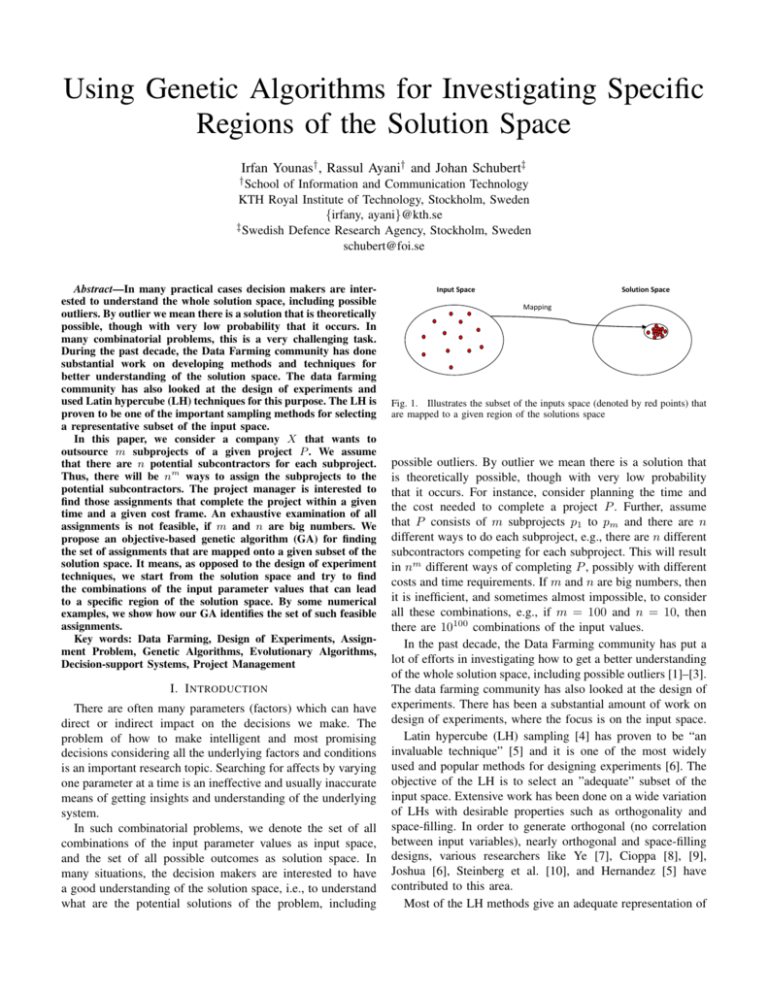
Using Genetic Algorithms for Investigating Specific
Regions of the Solution Space
Irfan Younas† , Rassul Ayani† and Johan Schubert‡
† School
of Information and Communication Technology
KTH Royal Institute of Technology, Stockholm, Sweden
{irfany, ayani}@kth.se
‡ Swedish Defence Research Agency, Stockholm, Sweden
schubert@foi.se
Abstract—In many practical cases decision makers are interested to understand the whole solution space, including possible
outliers. By outlier we mean there is a solution that is theoretically
possible, though with very low probability that it occurs. In
many combinatorial problems, this is a very challenging task.
During the past decade, the Data Farming community has done
substantial work on developing methods and techniques for
better understanding of the solution space. The data farming
community has also looked at the design of experiments and
used Latin hypercube (LH) techniques for this purpose. The LH is
proven to be one of the important sampling methods for selecting
a representative subset of the input space.
In this paper, we consider a company X that wants to
outsource m subprojects of a given project P . We assume
that there are n potential subcontractors for each subproject.
Thus, there will be nm ways to assign the subprojects to the
potential subcontractors. The project manager is interested to
find those assignments that complete the project within a given
time and a given cost frame. An exhaustive examination of all
assignments is not feasible, if m and n are big numbers. We
propose an objective-based genetic algorithm (GA) for finding
the set of assignments that are mapped onto a given subset of the
solution space. It means, as opposed to the design of experiment
techniques, we start from the solution space and try to find
the combinations of the input parameter values that can lead
to a specific region of the solution space. By some numerical
examples, we show how our GA identifies the set of such feasible
assignments.
Key words: Data Farming, Design of Experiments, Assignment Problem, Genetic Algorithms, Evolutionary Algorithms,
Decision-support Systems, Project Management
I. I NTRODUCTION
There are often many parameters (factors) which can have
direct or indirect impact on the decisions we make. The
problem of how to make intelligent and most promising
decisions considering all the underlying factors and conditions
is an important research topic. Searching for affects by varying
one parameter at a time is an ineffective and usually inaccurate
means of getting insights and understanding of the underlying
system.
In such combinatorial problems, we denote the set of all
combinations of the input parameter values as input space,
and the set of all possible outcomes as solution space. In
many situations, the decision makers are interested to have
a good understanding of the solution space, i.e., to understand
what are the potential solutions of the problem, including
Input Space
Solution Space
Mapping
Fig. 1. Illustrates the subset of the inputs space (denoted by red points) that
are mapped to a given region of the solutions space
possible outliers. By outlier we mean there is a solution that
is theoretically possible, though with very low probability
that it occurs. For instance, consider planning the time and
the cost needed to complete a project P . Further, assume
that P consists of m subprojects p1 to pm and there are n
different ways to do each subproject, e.g., there are n different
subcontractors competing for each subproject. This will result
in nm different ways of completing P , possibly with different
costs and time requirements. If m and n are big numbers, then
it is inefficient, and sometimes almost impossible, to consider
all these combinations, e.g., if m = 100 and n = 10, then
there are 10100 combinations of the input values.
In the past decade, the Data Farming community has put a
lot of efforts in investigating how to get a better understanding
of the whole solution space, including possible outliers [1]–[3].
The data farming community has also looked at the design of
experiments. There has been a substantial amount of work on
design of experiments, where the focus is on the input space.
Latin hypercube (LH) sampling [4] has proven to be “an
invaluable technique” [5] and it is one of the most widely
used and popular methods for designing experiments [6]. The
objective of the LH is to select an ”adequate” subset of the
input space. Extensive work has been done on a wide variation
of LHs with desirable properties such as orthogonality and
space-filling. In order to generate orthogonal (no correlation
between input variables), nearly orthogonal and space-filling
designs, various researchers like Ye [7], Cioppa [8], [9],
Joshua [6], Steinberg et al. [10], and Hernandez [5] have
contributed to this area.
Most of the LH methods give an adequate representation of
the input space. However, it is unclear how well the selected
subset of the input space is mapped onto the solution space.
For instance, one may imagine the cases where the selected
subset of the input space is mapped to a small region of the
solution space as shown in Figure 1.
On the other hand, the main objective of this work is to
contribute to better understanding of the solution space. We
propose an objective-based genetic algorithm (GA) for finding
the set of input data that are mapped onto a given subset
of the solution space. It means, as opposed to the design
of experiment techniques, we try to answer to the following
question: Is there any combination of the input parameter
values that can lead to a solution within a given subset of the
solution space? For instance in case of projects outsourcing,
our objective could be to select the subcontractors such that
the cost is minimized and the time threshold is satisfied. By
varying the time threshold, we can find different economical,
feasible and cost efficient options.
The outline of the rest of this paper is as follows. In
Section II, a mathematical formulation of the problem is presented. In section III, the proposed GA heuristic is described
. Section IV presents the experimental results. Section V
discusses further applications of our GA. Finally we conclude
this paper in section VI.
II. P ROBLEM FORMULATION
In this paper, as an example, we consider a specific application where a company X wants to outsource m subprojects,
p1 to pm of a given project P . For each subproject, there are n
potential subcontractors. The proposed cost and time needed
to complete a subproject proposed by different subcontractors
generally differ. This means that for each subproject pi we
have n potential subcontractors and each of them contains a
cost and the completion time.
The objective is to find the best selection of the potential
subcontractors such that the cost is minimized and the total
time needed to complete all subprojects is less than a given
threshold. Thus the m subprojects are represented by m factors
and the n potential subcontractors by n levels. We define
c(pi , lj ) and t(pi , lj ) as the cost and time of performing
project pi by subcontractor lj respectively. We also asume
the dependency between subprojects by a graph similar to
Figure 2. The subprojects are represented by nodes on graph
G = {V, E}, where V = P ∪ {S, T } is the set of nodes
representing subprojects and E is the set of directed edges
(arcs) representing the dependency (precedence constraints) of
subprojects. Here S and T are starting and terminating nodes.
For this scenario Optimality is defined as minimizing the
objective function (the cost function)
y(X ) =
m X
n
X
c(pi , lj )xij ,
n
X
xij = 1,
∀i|pi ∈ P
tcp
m+2 ≤ T,
(3)
where
cp
tcp
i = max {tk +
(k,i)∈E
n
X
t(pi , lj )xij },
∀i ∈ V \{S}
(4)
j=1
in Topological (linearized) order
xij ∈ {0, 1}
∀ij|pi ∈ P, lj ∈ L
(5)
Constraint (2) ensures that each factor is assigned to one
level and constraint (3) defines the feasible region of the
search space. Constraint (3) shows that time for critical path
(tcp
m+2 is the time of the longest path from starting node S to
teriminating node T ) of a solution should be less than or equal
cp
to the defined time threshold. T cp = {tcp
1 , . . . , tm+2 } is the
vector for maintaining times (accumulative of all predecessors)
of m + 2 vertices (nodes).
III. THE GA HEURISTIC
Genetic algorithms (GAs) [11], [12] are famous meta heuristics which are inspired by evolutionary ideas of genetics and
natural selection [13]. GAs may be adopted using specific
features of an application or by using a general Evolutionary
Computing Modeling Language (ECML) proposed in [14]. In
this paper, we develop a GA tailored to the project management problem. Our GA works with population of individuals
which are called potential solutions. Each potential solution
consists of a set of genes and the collection of these genes
form a chromosome. Each chromosome in GA represents
one candidate solution for the problem. The GAs evolve
the population of candidate solutions. The first population
is generated at random and the fitness value is calculated
according to given fitness function. In each iteration some
of the promising solutions are selected from the population
of candidate solutions. New candidate solutions are created
by applying crossover and mutation to the chosen solutions.
Due to crossover, the generated solutions inherit characteristics
from both parents. Mutation prevents the loss of diversity [13]
and is helpful to traverse different regions of search space to
locate hidden solutions by escaping local minima/maxima. The
steps involved in our algorithm are as follows:
(1)
i=1 j=1
(Here X = [xij ]m×n is an assignment matrix where xij = 1
if level lj is assigned to factor pi and 0 otherwise.)
subject to constraints
(2)
j=1
Fig. 2.
Dependency Graph for subprojects
Factors
1
2
3
4
5
6
7
8
9
10
Levels
3
5
3
2
4
5
2
6
2
5
Fig. 3.
Chromosome representation of a candidate solution
1) First step is to devise a suitable representation scheme
for candidate solutions (which are called chromosomes
in GA literature). In our problem, the set of given factors
is represented by a m-dimensional vector of integer
values where each factor pi ∈ P takes a level lj ∈ L.
For example, consider a case where we have 10 factors
and we assume that there are 6 levels for each factor.
Figure 3 shows a possible assignment of n levels to m
factors where m = 10 and n = 6 and Figure 2 shows
the dependency graph of m factors. An initial population
with M distinct candidate solutions (sample points) is
constructed by randomly assigning levels to factors. The
identical solutions can be cause of early convergence to
local minimum and we may not be able to find the global
optimal and other hidden solutions.
2) In order to evaluate the suitability of a candidate solution, fitness and unfitness values are calculated as
done in [15]. For the problem discussed in section II,
our objective function is to minimize the total cost
of the levels assigned to factors which is the fitness
value. The unfitness value is related to the violation of
constraints and it is a measure of infeasibility. Constraint
(3) ensures that the total time required to complete all
the subprojects should not exceed the defined threshold
T . Unfitness value us of a solution s is calculated in
similar way as done by Chu et al. [15] and is given by
us = max[0, tcp
m+2 − T ]
tcp
m+2
(6)
where
is the critial path (longest path with respect
to projects completion time which is the time necessary
to complete all the subprojects) which is represented by
equation (3) and (4) and is calculated using dynamic
programming [16], [17] as shown in Figure 4.
We can see from equation (6), that for a feasible solution
s, unfitness value us = 0. After calculating the fitness
and unfitness values, the population of individuals is
sorted based on two values (unfitness and fitness). For
feasible solutions (us = 0), the candidate solutions with
lower cost are said to be more suitable (fit). On the
other hand, solutions with highest unfitness value are
the weakest individuals.
3) Selection criteria is applied to choose two potential
solutions for reproduction from the population. There are
different selection schemes as discussed by Goldberg et
al. [18]. We choose binary tournament selection which
was also used in [15] where two individuals are selected
randomly with same likelihood of being selected. The
fitter individual is allocated for reproduction trial. For
reproduction two parents are chosen by conducting two
Fig. 4. Algorithm: Longest Path of projects dependency graph (minimum
time necessary to complete all the projects)
independent binary tournaments.
4) Two children are generated by applying crossover operator to the chosen parent solutions. There are different crossover operators. We choose one-point crossover
in which the crossover point p is randomly selected
between 1 and m. Child A takes first p genes from
parent X and the remaining m − p genes from parent
Y while child B takes first p genes from parent Y
and the remaining m − p genes from parent X. A
child in this way inherits features from both parents
and thus represents a different point in the input space.
The ultimate objective of the GA is to transfer the
characteristics from stronger individuals to their children
from generation to generation and evolve the population
according to the defined objective function.
5) Generally, the GA can be trapped by local minimum/maximum. In order to escape from these local
optimums and to explore different regions of the search
space, we use mutation operator. There are different
mutation operators which are selected according to representation scheme of individuals. For our problem we
select simple mutation operator in which one of the factor is assigned a random level lj ∈ L with some defined
mutation probability p. After crossover and mutation
the corresponding child solution can be infeasible (for
example in our case the time for completing all tasks
can exceed total threshold T ). Sorting of chromosomes
is done with respect to fitness and unfitness value and
the solutions which are infeasible they have unfitness
value > 0 and they are considered poor solutions.
6) In order to evolve the population keeping it constant
throughout the process, replacement scheme is applied
to replace an individual in the population with the
generated children chromosomes. In our approach the
weakest (worst) individual in the population is replaced
v
4
13
1
8
5
S
17
11
2
14
20
9
6
18
12
3
22
T
21
10
7
23
15
19
24
16
Fig. 5.
Dependency Graph of subProjects
by the child solution.
7) The iterative process (from steps 3 to 6) is repeated
until some termination criteria or condition for solution
quality is satisfied. For example we say that the algorithm should terminate when we have generated N nonduplicate children without improving the best candidate
solution found so far.
On termination of the algorithm, we have a better
(stronger) population of individuals than the initial population. By analyzing these candidate solutions, decision
makers and analysts can find different options which are
more flexible, feasible and matching to their interests.
IV. EXPERIMENTAL RESULTS
In this section, we present a set of experiments and the
obtained results. We consider a company X that wants to
outsource its m subprojects, where there are n subcontractors
for each of them. For our experiments we assume that m = 24
and n = 5 and the dependencies of the subprojects are shown
by a graph G = {V, E} (see Figure 5), where V = P ∪ {S, T }
is a set of nodes representing subprojects and E is the set of
directed edges (arcs) representing the dependency (precedence
constraints) of subprojects. In the Figure 5, S and T are the
starting and terminating nodes. A directed arc (pi , pk ) ∈ E
depicts that the subproject pk is dependent on subproject pi ,
i.e., pi must be completed before pk is started.
For input data, we generate synthetic cost and completion
time of each subproject. We denote the estimated cost of
subproject pi by ci and generate it as a random number within
[100, 400]. Similarly, the estimated completion time of pi is
denoted by ti and is generated as a random number within
[100, 200]. Once ci and ti are estimated we generate 5 pairs
(ci1 , ti1 ), (ci2 , ti2 ), (ci3 , ti3 ), (ci4 , ti4 ) and (ci5 , ti5 ) corresponding to the cost and time of the five offers submitted by
the five potential subcontractors for pi (where cij = c(pi , lj )
and tij = t(pi , lj )). We assume that 0.5ci ≤ cij ≤ 1.5ci and
0.8ti ≤ tij ≤ 1.2ti , ∀i ∈ {1, . . . , m} and ∀j ∈ {1, . . . , n}.
Now we can identify the solution space by determining:
(a) The minimum time needed for completing all subprojects, Tmin .
(b) The minimum cost required for completing all subprojects, , Cmin .
(c) The maximum time needed for completing all subprojects, Tmax .
(d) The maximum cost for completing all subprojects,
Cmax .
Tmin (and Tmax ) can be calculated by selecting the subcontractor with the lowest (and highest) completion time for each
subproject (without taking into account the cost) and sum up
the time for nodes on the critical path of the corresponding
graph i.e.,
Tmin = tcp
(7)
m+2 ,
where
cp
tcp
i = max {tk + min {tij }},
(k,i)∈E
1≤j≤n
∀i ∈ V \{S}
Tmax = tcp
m+2 ,
(8)
(9)
where
cp
tcp
i = max {tk + max {tij }},
1≤j≤n
(k,i)∈E
∀i ∈ V \{S}
(10)
Similarly, Cmin (and Cmax ) can be easily calculated by
selecting the subcontractor with the lowest (and highest)
proposed cost for each subproject, without taking into account
the completion times, i.e.,
Cmin =
m
X
i=1
Cmax =
m
X
i=1
min {cij }
(11)
max {cij }
(12)
1≤j≤n
1≤j≤n
Cost
Cmax
Cmin
Tmin
Fig. 6.
Tmax
Time
Solution Space (bordered by rectangle)
TABLE I
20 D ESIGN P OINTS USING N EARLY O RTHOGONAL AND S PACE F ILLING L ATIN H YPERCUBES
Individual #
Total cost
Total time
1
2
3
4
5
6
7
8
9
10
11
12
13
14
15
16
17
18
19
20
4714
4933
5063
5074
5094
5126
5202
5207
5242
5249
5284
5299
5304
5337
5340
5340
5345
5349
5351
5351
1515
1423
1375
1438
1455
1451
1397
1449
1434
1381
1407
1436
1355
1409
1368
1449
1423
1475
1438
1441
Possible Assignment of subcontractors to subprojects (24-dimensional vector
represents subprojects and the integer values denote the subcontractor assigned
to each subproject)
[3, 3, 5, 5, 3, 1, 5, 2, 3, 4, 1, 1, 3, 2, 5, 4, 3, 3, 3, 1, 2, 4, 1, 4]
[3, 4, 2, 2, 2, 3, 4, 1, 3, 5, 2, 4, 3, 2, 5, 4, 3, 1, 4, 5, 1, 5, 3, 4]
[4, 3, 3, 3, 4, 3, 2, 4, 3, 2, 5, 1, 3, 5, 3, 1, 2, 5, 5, 2, 3, 1, 3, 3]
[3, 3, 5, 5, 4, 3, 3, 4, 1, 4, 2, 3, 4, 5, 1, 4, 2, 2, 4, 3, 5, 4, 2, 2]
[2, 5, 3, 5, 5, 1, 3, 5, 3, 5, 4, 3, 3, 5, 3, 3, 3, 2, 3, 1, 1, 4, 4, 3]
[1, 5, 5, 5, 4, 4, 3, 3, 3, 4, 4, 1, 1, 5, 5, 4, 3, 2, 1, 4, 3, 3, 3, 1]
[3, 5, 4, 1, 5, 4, 5, 4, 4, 2, 1, 1, 3, 5, 4, 1, 1, 3, 4, 2, 1, 5, 5, 3]
[2, 5, 2, 3, 5, 4, 5, 2, 3, 5, 4, 3, 2, 5, 3, 5, 3, 2, 3, 1, 4, 2, 5, 3]
[1, 5, 2, 3, 1, 3, 1, 4, 1, 1, 5, 3, 3, 5, 3, 5, 2, 3, 4, 2, 1, 4, 1, 3]
[5, 5, 2, 2, 4, 2, 3, 4, 2, 4, 1, 1, 2, 2, 2, 2, 4, 1, 3, 1, 3, 2, 1, 4]
[2, 5, 4, 2, 3, 4, 5, 3, 2, 1, 1, 2, 2, 1, 5, 2, 3, 5, 5, 3, 1, 1, 3, 4]
[5, 3, 2, 2, 5, 4, 1, 4, 1, 4, 5, 4, 2, 3, 2, 1, 5, 1, 4, 4, 1, 4, 1, 3]
[2, 3, 3, 4, 1, 2, 3, 2, 1, 4, 1, 5, 3, 5, 4, 3, 1, 5, 5, 4, 3, 3, 5, 4]
[5, 2, 2, 2, 3, 3, 2, 1, 4, 1, 2, 2, 4, 5, 2, 5, 3, 3, 5, 4, 3, 1, 5, 3]
[3, 3, 2, 3, 3, 2, 4, 2, 5, 4, 4, 2, 2, 3, 2, 2, 5, 3, 5, 4, 4, 5, 3, 3]
[1, 5, 3, 3, 5, 4, 1, 4, 5, 4, 4, 1, 3, 5, 5, 2, 5, 2, 2, 4, 2, 4, 5, 4]
[5, 5, 4, 5, 4, 4, 4, 5, 1, 1, 4, 3, 4, 1, 5, 4, 4, 5, 4, 4, 1, 2, 1, 2]
[2, 3, 3, 4, 2, 4, 3, 2, 3, 4, 2, 3, 4, 1, 4, 2, 4, 5, 1, 5, 3, 3, 5, 4]
[5, 2, 3, 2, 1, 5, 5, 1, 1, 3, 4, 4, 4, 5, 3, 4, 3, 5, 5, 1, 3, 5, 1, 3]
[4, 3, 2, 5, 5, 4, 3, 4, 1, 5, 4, 2, 2, 5, 5, 2, 2, 3, 5, 1, 2, 5, 5, 2]
Using equations (7), (9), (11) and (12) we obtain Tmin =
1192, Tmax = 1604, Cmin = 3575 and Cmax = 7773 and the
expected solution space is the rectangle shown in Figure 6.
space, since it fulfills the near orthogonality and space filling
requirements [9].
On the other hand, we may be interested to know which
design points are mapped into a specific region of the solution
space. For instance, in our outsourcing example the project
manager may raise the following questions:
(a) Which are the assignment vectors that complete the
project with the minimum cost Cmin ?
(b) Which are the assignment vectors that complete the
project in Tmin ?
(c) Can we identify the assignment vectors that complete
the project within a given time threshold T ? If so, then
list at most 20 of them with the lowest total cost?
Fig. 7. Representation of the solution space using Nearly Orthogonal and
space-filling Latin Hypercubes
First we select 257 points of the input space using nearly
orthogonal and space-filling Latin hypercubes (NOLH), suggested by Cioppa and Lucas [9]. Each point is represented
by a vector assigning each subproject to one of n potential
subcontractors. For readability reason we present 20 of these
design points in table I where each row represents a design
point (or an assignment of subprojects to the subcontractors).
Figure 7 shows how the 257 points are mapped onto the
solution space, i.e., the cost and time of each of these assignments. The generated design points (or assignment vectors)
using NOLH is shown to be a good representative of the input
Using our GA we obtain the answer to (a), (b) and (c) that
are represented in Tables II, III and IV respectively. Our GA
finds 4 design points that complete the project with the minimum cost, i.e., the total cost= 3575 (see Table II). Table III,
illustrates 20 of the assignment vectors that fulfill the time
constraint of question (b), i.e., the completion time is equal
to 1192. Actually, there are more assignment vectors fulfilling
this requirement, but for readability reason we present only
the best 20, namely those that fulfill the time constraint but
have the lowest cost. Similarly, Table IV illustrates 20 of the
assignment vectors that complete the whole project in 1380
time units. In tables II, III and IV, the bold figures in each
row identify the critical path of Figure 5 for that particular
assignment.
We implemented our GA in Java and run it on a PC
with a 3.16 GHz CPU and 3.49 GB of RAM. The initial
population is set to 257 and the algorithm is terminated when
10000 iterations have been performed without improving the
population.
TABLE II
D ESIGN P OINTS WITH MINIMUM COST ( WITHOUT ANY T IME THRESHOLD )
Individual #
Total cost
Total time
1
2
3
4
3575.0
3575.0
3575.0
3575.0
1418.0
1445.0
1485.0
1458.0
Possible Assignment of subcontractors to subprojects (24-dimensional vector
represents subprojects and the integer values denote the subcontractor assigned
to each subproject)
[1, 5, 5, 3, 4, 1, 5, 5, 3, 1, 2, 4, 1, 2, 3, 1, 1, 1, 5, 3, 3, 1, 2, 3]
[1, 5, 5, 3, 4, 1, 5, 5, 3, 1, 2, 4, 1, 2, 3, 1, 1, 1, 5, 3, 2, 1, 2, 3]
[1, 5, 5, 3, 4, 1, 5, 5, 3, 1, 2, 4, 1, 2, 1, 1, 1, 1, 5, 3, 2, 1, 2, 3]
[1, 5, 5, 3, 4, 1, 5, 5, 3, 1, 2, 4, 1, 2, 1, 1, 1, 1, 5, 3, 3, 1, 2, 3]
Bold figures in each row show the longest path (critical path) with respect to completion time of the subprojects
TABLE III
20 D ESIGN P OINTS THAT FULFILL THE M INIMUM T IME REQUIREMENT = 1192
Individual #
1
2
3
4
5
6
7
8
9
10
11
12
13
14
15
16
17
18
19
20
Total cost
Time Threshold
4470.0
1192
4471.0
1192
4479.0
1192
4480.0
1192
4497.0
1192
4498.0
1192
4501.0
1192
4502.0
1192
4506.0
1192
4506.0
1192
4507.0
1192
4507.0
1192
4510.0
1192
4511.0
1192
4512.0
1192
4513.0
1192
4515.0
1192
4516.0
1192
4517.0
1192
4521.0
1192
Bold figures in each row show
Possible Assignment of subcontractors to subprojects (24-dimensional vector
represents subprojects and the integer values denote the subcontractor assigned
to each subproject)
[4, 3, 3, 5, 4, 2, 5, 4, 2, 4, 2, 5, 1, 2, 5, 4, 1, 1, 5, 2, 1, 1, 5, 3]
[4, 3, 3, 5, 4, 2, 5, 2, 2, 4, 2, 5, 1, 2, 5, 4, 1, 1, 5, 2, 1, 1, 5, 3]
[4, 3, 3, 5, 4, 2, 5, 4, 2, 4, 2, 5, 1, 2, 5, 4, 1, 1, 5, 5, 1, 1, 5, 3]
[4, 3, 3, 5, 4, 2, 5, 2, 2, 4, 2, 5, 1, 2, 5, 4, 1, 1, 5, 5, 1, 1, 5, 3]
[4, 3, 3, 5, 4, 2, 3, 4, 2, 4, 2, 5, 1, 2, 5, 4, 1, 1, 5, 2, 1, 1, 5, 3]
[4, 3, 3, 5, 4, 2, 3, 2, 2, 4, 2, 5, 1, 2, 5, 4, 1, 1, 5, 2, 1, 1, 5, 3]
[4, 3, 3, 5, 4, 2, 5, 4, 2, 4, 2, 5, 1, 2, 2, 4, 1, 1, 5, 2, 1, 1, 5, 3]
[4, 3, 3, 5, 4, 2, 5, 2, 2, 4, 2, 5, 1, 2, 2, 4, 1, 1, 5, 2, 1, 1, 5, 3]
[4, 3, 3, 5, 4, 2, 3, 4, 2, 4, 2, 5, 1, 2, 5, 4, 1, 1, 5, 5, 1, 1, 5, 3]
[4, 3, 3, 5, 4, 2, 4, 4, 2, 4, 2, 5, 1, 2, 5, 4, 1, 1, 5, 2, 1, 1, 5, 3]
[4, 3, 3, 5, 4, 2, 4, 2, 2, 4, 2, 5, 1, 2, 5, 4, 1, 1, 5, 2, 1, 1, 5, 3]
[4, 3, 3, 5, 4, 2, 3, 2, 2, 4, 2, 5, 1, 2, 5, 4, 1, 1, 5, 5, 1, 1, 5, 3]
[4, 3, 3, 5, 4, 2, 5, 4, 2, 4, 2, 5, 1, 2, 2, 4, 1, 1, 5, 5, 1, 1, 5, 3]
[4, 3, 3, 5, 4, 2, 5, 2, 2, 4, 2, 5, 1, 2, 2, 4, 1, 1, 5, 5, 1, 1, 5, 3]
[4, 3, 3, 5, 4, 2, 5, 4, 2, 4, 2, 5, 1, 1, 5, 4, 1, 1, 5, 2, 1, 1, 5, 3]
[4, 3, 3, 5, 4, 2, 5, 2, 2, 4, 2, 5, 1, 1, 5, 4, 1, 1, 5, 2, 1, 1, 5, 3]
[4, 3, 3, 5, 4, 2, 4, 4, 2, 4, 2, 5, 1, 2, 5, 4, 1, 1, 5, 5, 1, 1, 5, 3]
[4, 3, 3, 5, 4, 2, 4, 2, 2, 4, 2, 5, 1, 2, 5, 4, 1, 1, 5, 5, 1, 1, 5, 3]
[4, 3, 3, 5, 3, 2, 5, 5, 2, 4, 2, 5, 1, 2, 5, 4, 1, 1, 5, 5, 1, 1, 5, 3]
[4, 3, 3, 5, 4, 2, 5, 4, 2, 4, 2, 5, 1, 1, 5, 4, 1, 1, 5, 5, 1, 1, 5, 3]
the longest path (critical path) with respect to completion time of the subprojects
TABLE IV
20 D ESIGN P OINTS THAT FULFILL REQUIRED T IME T HRESHOLD = 1380
Individual #
Total cost
Total time
Time Threshold
1
2
3
4
5
6
7
8
9
10
11
12
13
14
15
16
17
18
19
20
3606.0
3609.0
3613.0
3616.0
3616.0
3617.0
3620.0
3623.0
3624.0
3624.0
3624.0
3624.0
3624.0
3627.0
3627.0
3627.0
3627.0
3627.0
3628.0
3631.0
1373.0
1368.0
1373.0
1373.0
1368.0
1373.0
1379.0
1373.0
1380.0
1373.0
1373.0
1373.0
1373.0
1375.0
1379.0
1373.0
1368.0
1374.0
1373.0
1380.0
1380
1380
1380
1380
1380
1380
1380
1380
1380
1380
1380
1380
1380
1380
1380
1380
1380
1380
1380
1380
Possible Assignment of subcontractors to subprojects (24-dimensional vector
represents subprojects and the integer values denote the subcontractor assigned
to each subproject)
[3, 5, 5, 3, 4, 2, 5, 5, 3, 1, 2, 4, 1, 2, 3, 1, 1, 1, 5, 3, 3, 1, 2, 3]
[1, 5, 5, 3, 4, 2, 5, 5, 3, 1, 2, 4, 1, 2, 5, 1, 1, 1, 5, 3, 3, 1, 2, 3]
[3, 3, 5, 3, 4, 2, 5, 5, 3, 1, 2, 4, 1, 2, 3, 1, 1, 1, 5, 3, 3, 1, 2, 3]
[5, 5, 5, 3, 4, 2, 5, 5, 3, 1, 2, 4, 1, 2, 3, 1, 1, 1, 5, 3, 3, 1, 2, 3]
[1, 3, 5, 3, 4, 2, 5, 5, 3, 1, 2, 4, 1, 2, 5, 1, 1, 1, 5, 3, 3, 1, 2, 3]
[3, 5, 5, 3, 4, 2, 5, 5, 3, 1, 2, 4, 1, 2, 3, 1, 1, 3, 5, 3, 3, 1, 2, 3]
[1, 5, 5, 3, 4, 2, 5, 5, 3, 1, 2, 4, 1, 2, 5, 1, 1, 3, 5, 3, 3, 1, 2, 3]
[5, 3, 5, 3, 4, 2, 5, 5, 3, 1, 2, 4, 1, 2, 3, 1, 1, 1, 5, 3, 3, 1, 2, 3]
[3, 5, 5, 3, 4, 2, 5, 5, 3, 1, 2, 4, 1, 2, 3, 1, 1, 1, 5, 1, 3, 1, 2, 3]
[4, 5, 5, 3, 4, 2, 5, 5, 3, 1, 2, 4, 1, 2, 3, 1, 1, 1, 5, 3, 3, 1, 2, 3]
[3, 3, 5, 3, 4, 2, 5, 5, 3, 1, 2, 4, 1, 2, 3, 1, 1, 3, 5, 3, 3, 1, 2, 3]
[3, 5, 5, 3, 4, 2, 5, 5, 3, 1, 2, 4, 1, 2, 3, 1, 1, 1, 5, 3, 3, 4, 2, 3]
[3, 5, 5, 3, 4, 2, 5, 5, 3, 1, 2, 4, 3, 2, 3, 1, 1, 1, 5, 3, 3, 1, 2, 3]
[1, 5, 5, 3, 4, 2, 5, 5, 3, 1, 2, 4, 1, 2, 5, 1, 1, 1, 5, 1, 3, 1, 2, 3]
[1, 3, 5, 3, 4, 2, 5, 5, 3, 1, 2, 4, 1, 2, 5, 1, 1, 3, 5, 3, 3, 1, 2, 3]
[5, 5, 5, 3, 4, 2, 5, 5, 3, 1, 2, 4, 1, 2, 3, 1, 1, 3, 5, 3, 3, 1, 2, 3]
[1, 5, 5, 3, 4, 2, 5, 5, 3, 1, 2, 4, 1, 2, 5, 1, 1, 1, 5, 3, 3, 4, 2, 3]
[3, 5, 5, 3, 4, 2, 5, 5, 3, 1, 2, 4, 1, 2, 3, 1, 1, 1, 5, 3, 3, 1, 2, 4]
[3, 5, 5, 3, 4, 2, 1, 5, 3, 1, 2, 4, 1, 2, 3, 1, 1, 1, 5, 3, 3, 1, 2, 3]
[3, 3, 5, 3, 4, 2, 5, 5, 3, 1, 2, 4, 1, 2, 3, 1, 1, 1, 5, 1, 3, 1, 2, 3]
Bold figures in each row show the longest path (critical path) with respect to completion time of the subprojects
V. D ISCUSSION
VI. S UMMARY AND C ONCLUSION
In the outsourcing problem discussed in this paper, the
manager may be interested to find different assignments of
subprojects to subcontractors that satisfy a given time and cost
constraint. For instance, assume that it is required that the cost
of the project is less than Cu (upper bound on cost) and the
time needed to complete the project is less than Tthreshold .
These requirements correspond to the region of the solution
space shown in Figure 8. Our GA based approach provides
several feasible assignments of subprojects to subcontractors
and thus the decision makers have the possibility of selecting
the most suitable one.
In this example, we assumed that there are m subprojects
and n potential subcontractors for each of them. However, a
similar problem may arise if there is a single subcontractor for
each subproject with agreed upon time and cost, but there is a
risk that the completion time is delayed. For instance, assume
that company X and subcontractor Y have made the following
agreement in their contract: If Y does not complete his work
on time, then a penalty of D dollars per day must be paid to X.
This will lead to potentially n different costs and completion
times for each subproject, where n is the maximum number
of days a subcontractor may delay the subproject.
Our approach can also be easily applied to other cases than
the outsourcing, where one is interested in finding the subset
of the input space (or design points) that is mapped onto a
specific region of the solution space, similar to the one shown
in Figure 8.
Our GA starts with a randomly selected initial population
and then by cross over and mutation operators tries to identify
those candidates that fulfill the objective function given in
section II. Thus, it is possible that some of the feasible
assignments are not detected. This is certainly a limitation
of using GA comparing to exhaustive search methods. On the
other hand, it is impractical to use exhaustive search when the
input space is very large, e.g., in big projects with hundreds
of subprojects.
In many practical situations, the decision makers may be
interested to understand the whole solution space, including
possible outliers. The Data Farming community has put a lot
of efforts in developing methods and techniques for achieving
this goal and has used some of the techniques and methods
developed in experiment design, such as the Nearly Orthogonal
and space-filling Latin Hypercubes (NOLH). In this work,
we looked at an outsourcing example but from a different
angle. We considered the case where the decision makers
are interested in a specific region of the solution space and
investigated how to identify those assignments that would be
mapped onto this region. We developed a genetic algorithm
that randomly selects an initial set of design points and then
by cross over and mutation operators tries to identify those
candidates that are mapped into the region of interest. We
provided a few numerical examples and showed how our GA
finds the design points that are mapped into the region of
interest. The GA can be used to investigate any part of the
solution space, simply by redefining the region of interest.
Cost
Cmax
Interested region of
the Solution Space
Cu
Cmin
Tthreshold
Tmin
Fig. 8.
Tmax
Time
Interested Region of Solution Space (dark rectangle)
ACKNOWLEDGMENT
We would like to thank Christian Schulte for his comments
and suggestions.
R EFERENCES
[1] G. E. Horne and T. E. Meyer, “Data farming: discovering surprise,” in
Proceedings of the 36th conference on Winter simulation, ser. WSC ’04.
Winter Simulation Conference, 2004, pp. 807–813.
[2] J. P. C. Kleijnen, S. M. Sanchez, T. W. Lucas, and T. M. Cioppa, “A
users guide to the brave new world of designing simulation experiments,”
INFORMS Journal on Computing, vol. 17, no. 3, pp. 263–289, 2005.
[3] S. M. Sanchez and H. Wan, “Better than a petaflop: The power
of efficient experimental design,” in Proceedings of the 2009 Winter
Simulation Conference, A. Dunkin, R. G. Ingalls, E. Yücesan, M. D.
Rossetti, R. Hill, and B. Johansson, Eds., Austin, TX, USA, 2009, pp.
60–74.
[4] M. D. McKay, R. J. Beckman, and W. J. Conover, “Comparison of three
methods for selecting values of input variables in the analysis of output
from a computer code,” Technometrics, vol. 21, no. 2, pp. 239–245,
1979.
[5] A. S. Hernandez, “Breaking barriers to design dimensions in nearly
orthogonal latin hypercubes,” Ph.D. dissertation, Naval Postgraduate
School, Monterey, CA, U.S.A., 2008.
[6] A. K.-E. Joshua, “Extending orthogonal and nearly orthogonal latin hypercube designs for computer simulation and experimentation,” Master’s
thesis, Naval Postgraduate School, Monterey, CA, U.S.A., 2006.
[7] K. Q. Ye, “Orthogonal column latin hypercubes and their application in
computer experiments,” Journal of the American Statistical Association,
vol. 93, no. 444, pp. 1430–1439, 1998.
[8] T. M. Cioppa, “Efficient nearly orthogonal and space-filling experimental
designs for high-dimensional complex models,” Ph.D. dissertation, Naval
Postgraduate School, Monterey, CA, U.S.A., 2002.
[9] T. M. Cioppa and T. W. Lucas, “Efficient nearly orthogonal and spacefilling latin hypercubes,” Technometrics, vol. 49, no. 1, pp. 45–55, 2007.
[10] D. M. Steinberg and D. K. J. Lin, “Orthogonal column latin hypercubes
and their application in computer experiments,” Biometrika, vol. 93, pp.
279–288, 2006.
[11] M. Mitchell, Introduction to genetic algorithms. Cambridge, Massachusetts: MIT Press, 1999.
[12] D. E. Goldberg, Genetic Algorithms in Search, Optimization and Machine Learning. Massachusetts: Addison Wesley, 1989.
[13] J. H. Holland, Adaptation in natural and artificial systems. Cambridge,
MA, USA: MIT Press, 1992.
[14] H. Aydt, S. J. Turner, W. Cai, M. Y. H. Low, Y.-S. Ong, and R. Ayani,
“Towards an evolutionary computing modeling language,” IEEE Transactions on Evolutionary Computation, vol. 15, pp. 230–247, April 2011.
[15] P. C. Chu and J. E. Beasley, “A genetic algorithm for the generalised
assignment problem,” Computers and Operations Research, vol. 24, pp.
17–23, January 1997.
[16] T. H. Cormen, C. E. Leiserson, R. L. Rivest, and C. Stein, Introduction
to Algorithms. MIT Press and McGraw-Hill, 2001.
[17] S. Dasgupta, C. Papadimitriou, and U. Vazirani, Algorithms. McGrawHill, 2006.
[18] D. E. Goldberg and K. Deb, “A comparative analysis of selection
schemes used in genetic algorithms,” in Foundations of Genetic Algorithms. Morgan Kaufmann, 1991, pp. 69–93.

